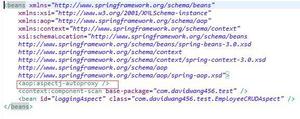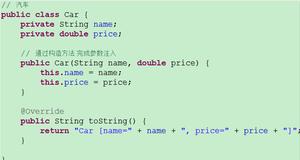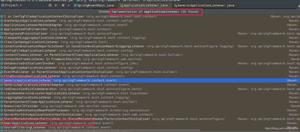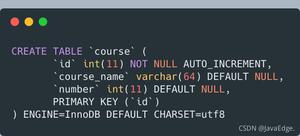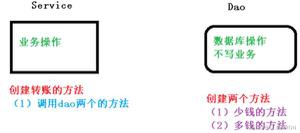spring aop 声明式事务管理
本文内容纲要:spring aop 声明式事务管理
Spring使用AOP来完成声明式的事务管理 有annotation和xml两种形式
代码和上一篇基本相近,再贴一遍
两个实体类
package com.ouc.wkp.model;import javax.persistence.Entity;
import javax.persistence.GeneratedValue;
import javax.persistence.Id;
@Entity(name = "t_log")
public class Log {
private int id;
private String msg;
@Id
@GeneratedValue
public int getId() {
return id;
}
public void setId(int id) {
this.id = id;
}
public String getMsg() {
return msg;
}
public void setMsg(String msg) {
this.msg = msg;
}
}
Log.java
package com.ouc.wkp.model;import javax.persistence.Column;
import javax.persistence.Entity;
import javax.persistence.GeneratedValue;
import javax.persistence.Id;
@Entity(name="user2")
public class User2 {
private int id;
private String username;
@Id
@GeneratedValue
public int getId() {
return id;
}
public void setId(int id) {
this.id = id;
}
@Column
public String getUsername() {
return username;
}
public void setUsername(String username) {
this.username = username;
}
}
User2.java
两个接口DAO
package com.ouc.wkp.dao;import com.ouc.wkp.model.Log;
public interface LogDAO {
public void save(Log log);
}
LogDAO.java
package com.ouc.wkp.dao;import com.ouc.wkp.model.User2;
public interface UserDAO {
public void save(User2 user2);
public void delete();
}
UserDAO.java
接口实现
package com.ouc.wkp.dao.impl;import java.sql.Connection;
import java.sql.SQLException;
import javax.annotation.Resource;
import javax.sql.DataSource;
import org.hibernate.Session;
import org.hibernate.SessionFactory;
import org.springframework.stereotype.Component;
import com.ouc.wkp.dao.UserDAO;
import com.ouc.wkp.model.User2;
@Component("u")
public class UserDAOImpl implements UserDAO {
// private DataSource dataSource;
//
// public DataSource getDataSource() {
// return dataSource;
// }
//
// @Resource
// public void setDataSource(DataSource dataSource) {
// this.dataSource = dataSource;
// }
private SessionFactory sessionFactory;
public SessionFactory getSessionFactory() {
return sessionFactory;
}
@Resource
public void setSessionFactory(SessionFactory sessionFactory) {
this.sessionFactory = sessionFactory;
}
@Override
public void save(User2 user2) {
// Hibernate
// JDBC
// XML
// NetWork
// System.out
// .println("session factory class:" + sessionFactory.getClass());
Session s = sessionFactory.getCurrentSession();
// s.beginTransaction();
s.save(user2);
// s.getTransaction().commit();
// System.out.println("user saved!");
}
@Override
public void delete() {
// TODO Auto-generated method stub
}
}
UserDAOImpl.java
package com.ouc.wkp.dao.impl;import javax.annotation.Resource;
import org.hibernate.Session;
import org.hibernate.SessionFactory;
import org.springframework.stereotype.Component;
import com.ouc.wkp.dao.LogDAO;
import com.ouc.wkp.model.Log;
@Component("logDAO")
public class LogDAOImpl implements LogDAO {
private SessionFactory sessionFactory;
public SessionFactory getSessionFactory() {
return sessionFactory;
}
@Resource
public void setSessionFactory(SessionFactory sessionFactory) {
this.sessionFactory = sessionFactory;
}
@Override
public void save(Log log) {
Session s = sessionFactory.getCurrentSession();
s.save(log);
// throw new RuntimeException();//事务会回滚 spring配置后省去了try catch
}
}
LogDAOImpl.java
package com.ouc.wkp.service;import javax.annotation.Resource;
import org.springframework.stereotype.Component;
import org.springframework.transaction.annotation.Propagation;
import org.springframework.transaction.annotation.Transactional;
import com.ouc.wkp.dao.LogDAO;
import com.ouc.wkp.dao.UserDAO;
import com.ouc.wkp.model.Log;
import com.ouc.wkp.model.User2;
@Component("userService")
public class UserService {
private UserDAO userDAO;
private LogDAO logDAO;
public LogDAO getLogDAO() {
return logDAO;
}
@Resource(name = "logDAO")
public void setLogDAO(LogDAO logDAO) {
this.logDAO = logDAO;
}
public User2 getUser(int id) {
return null;
}
public void init() {
System.out.println("init");
}
// @Transactional(propagation = Propagation.REQUIRED)
// 事务的传播特性 默认REQUIRED
// readOnly=true只读的 spring会进行优化
// 声明式事务管理 进行事务
public void add(User2 user2) {
userDAO.save(user2);
Log log = new Log();
log.setMsg("a user saved");
logDAO.save(log);
}
public UserDAO getUserDAO() {
return userDAO;
}
@Resource(name = "u")
public void setUserDAO(UserDAO userDAO) {
this.userDAO = userDAO;
}
public void destroy() {
System.out.println("destroy");
}
}
UserService.java
使用注解时在对应的方法前加上@Transactional(propagation = Propagation.REQUIRED)
(propagation = Propagation.REQUIRED)可以省去,因为事务的传播特性 默认为REQUIRED
配置文件
1 <?xml version="1.0" encoding="UTF-8"?> 2 <beans xmlns="http://www.springframework.org/schema/beans"
3 xmlns:xsi="http://www.w3.org/2001/XMLSchema-instance" xmlns:context="http://www.springframework.org/schema/context"
4 xmlns:aop="http://www.springframework.org/schema/aop" xmlns:tx="http://www.springframework.org/schema/tx"
5 xsi:schemaLocation="http://www.springframework.org/schema/beans
6 http://www.springframework.org/schema/beans/spring-beans-3.1.xsd
7 http://www.springframework.org/schema/context
8 http://www.springframework.org/schema/context/spring-context-3.1.xsd
9 http://www.springframework.org/schema/aop
10 http://www.springframework.org/schema/aop/spring-aop-3.1.xsd
11 http://www.springframework.org/schema/tx
12 http://www.springframework.org/schema/tx/spring-tx-3.1.xsd">
13 <context:annotation-config />
14 <!-- 使用注解需要下面四条 -->
15 <!-- xmlns:context="http://www.springframework.org/schema/context" -->
16 <!-- http://www.springframework.org/schema/context -->
17 <!-- http://www.springframework.org/schema/context/spring-context-3.1.xsd"> -->
18 <!-- <context:annotation-config /> -->
19
20 <!-- 使用aop需要一下 -->
21 <!-- xmlns:aop="http://www.springframework.org/schema/aop" -->
22 <!-- http://www.springframework.org/schema/aop -->
23 <!-- http://www.springframework.org/schema/aop/spring-aop-2.5.xsd"> -->
24 <!-- <aop:aspectj-autoproxy /> -->
25
26 <!-- 使用事务 -->
27 <!-- xmlns:tx="http://www.springframework.org/schema/tx" -->
28 <!-- http://www.springframework.org/schema/tx -->
29 <!-- http://www.springframework.org/schema/tx/spring-tx-2.5.xsd -->
30 <!-- <tx:annotation-driven transaction-manager="txManager"/> -->
31
32
33 <!-- 扫描 -->
34 <context:component-scan base-package="com.ouc.wkp"></context:component-scan>
35
36 <aop:aspectj-autoproxy />
37
38 <bean
39 class="org.springframework.beans.factory.config.PropertyPlaceholderConfigurer">
40 <property name="locations">
41 <value>classpath:jdbc.properties</value>
42 </property>
43 </bean>
44
45 <bean id="dataSource" destroy-method="close"
46 class="org.apache.commons.dbcp.BasicDataSource">
47 <property name="driverClassName" value="${jdbc.driverClassName}" />
48 <property name="url" value="${jdbc.url}" />
49 <property name="username" value="${jdbc.username}" />
50 <property name="password" value="${jdbc.password}" />
51 </bean>
52
53 <bean id="sessionFactory"
54 class="org.springframework.orm.hibernate4.LocalSessionFactoryBean">
55 <property name="dataSource" ref="dataSource" />
56 <!-- <property name="annotatedClasses"> -->
57 <!-- <list> -->
58 <!-- <value>com.ouc.wkp.model.User2</value> -->
59 <!-- <value>com.ouc.wkp.model.Log</value> -->
60 <!-- </list> -->
61 <!-- </property> -->
62 <property name="packagesToScan">
63 <list>
64 <value>com.ouc.wkp.model</value>
65 </list>
66 </property>
67 <property name="hibernateProperties">
68 <props>
69 <prop key="hibernate.dialect">
70 org.hibernate.dialect.MySQLDialect
71 </prop>
72 <prop key="hibernate.show_sql">true</prop>
73 </props>
74 </property>
75 </bean>
76
77
78 <!-- Spring使用AOP来完成声明式的事务管理 -->
79 <bean id="txManager"
80 class="org.springframework.orm.hibernate4.HibernateTransactionManager">
81 <!-- <property name="dataSource" ref="dataSource" /> -->
82 <property name="sessionFactory" ref="sessionFactory" />
83 </bean>
84
85 <tx:annotation-driven transaction-manager="txManager" />
86
87 <aop:config>
88 <aop:pointcut expression="execution(public * com.ouc.wkp.service..*.*(..))"
89 id="businessService" />
90 <!-- 在此pointcut上加上txAdvice建议 -->
91 <aop:advisor advice-ref="txAdvice" pointcut-ref="businessService" />
92 </aop:config>
93
94 <tx:advice id="txAdvice" transaction-manager="txManager">
95 <tx:attributes>
96 <tx:method name="getUser" read-only="true" />
97 <tx:method name="add*" propagation="REQUIRED" />
98 </tx:attributes>
99 </tx:advice>
100
101 </beans>
beans.xml
两个地方需要注意
1.这种方式可以省去写多个model类的配置
bean定义了一个事务管理,注入sessionFactory。
紧接着规定事务管理器为txManager即上面bean中定义的。
aop:config定义一个切面,在这个切面加上advice。
最后定义一个advice,
<tx:method name="getUser" read-only="true" />表示getUser方法是只读的并且进行了声明式事务管理。readonly可以提高程序效率。
<tx:method name="add*" propagation="REQUIRED" />标识为以add开头的方法添加事务。
测试类
package com.ouc.wkp.test;import org.junit.Test;
import org.springframework.context.support.ClassPathXmlApplicationContext;
import com.ouc.wkp.model.User2;
import com.ouc.wkp.service.UserService;
//Dependency Injection
//Inverse of Control
public class UserServiceTest {
@Test
public void testAdd() throws Exception {
ClassPathXmlApplicationContext ctx = new ClassPathXmlApplicationContext(
"beans.xml");
UserService service = (UserService) ctx.getBean("userService");
User2 user2=new User2();
user2.setId(1);
user2.setUsername("ttyy");
System.out.println(user2);
service.add(user2);
ctx.destroy();
}
}
UserServiceTest.java
如果出错则事务回滚,两条记录都增加失败。
本文内容总结:spring aop 声明式事务管理
原文链接:https://www.cnblogs.com/wangkaipeng/p/5782116.html
以上是 spring aop 声明式事务管理 的全部内容, 来源链接: utcz.com/z/362734.html

